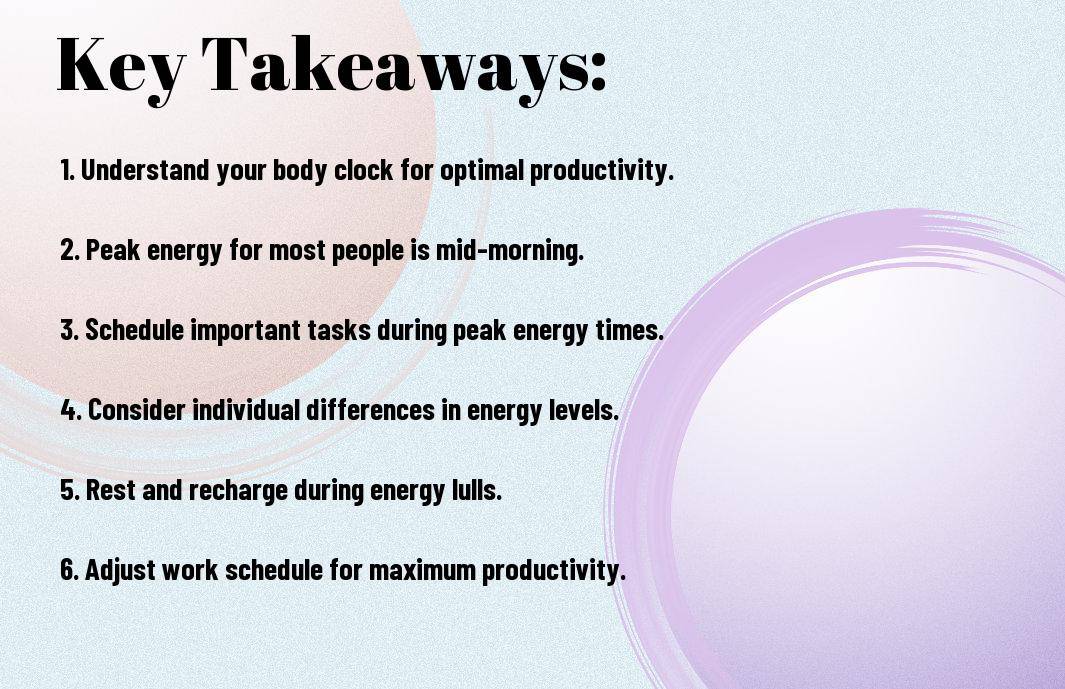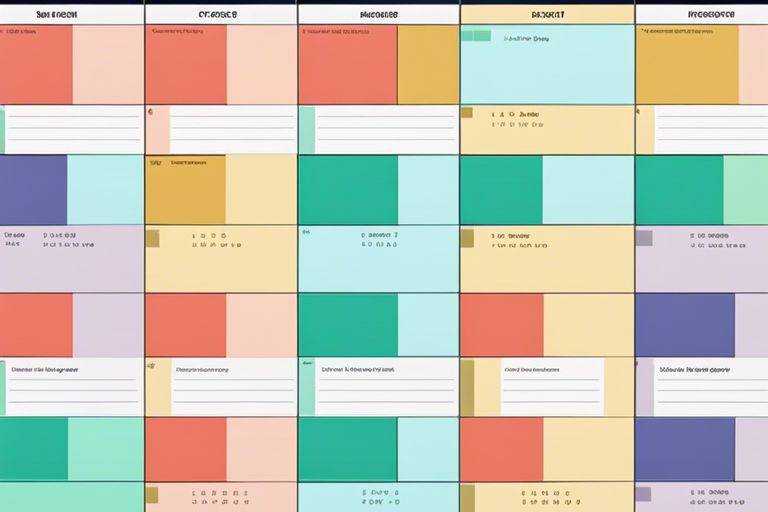It’s crucial for optimal performance to understand and leverage your body’s Biological Prime Time – the period of the day when your energy levels are at their peak. By scheduling tasks during this time, you can maximize your productivity and efficiency. This can lead to improved focus, creativity, and overall performance in your daily tasks.

Key Takeaways:
- Biological Prime Time: Identify your peak energy hours based on your natural body clock.
- Schedule Important Tasks: Plan high-priority tasks during your biological prime time for increased productivity.
- Avoid Low-Energy Tasks: Save routine or less critical tasks for when your energy levels naturally dip.
- Listen to Your Body: Pay attention to your energy patterns to optimize your schedule.
- Take Breaks: Allow yourself short breaks during the day to recharge and maintain productivity.
- Consistent Sleep Schedule: Ensure you get enough rest to maximize your energy levels during your prime time.
- Experiment and Adjust: Test different schedules to find what works best for you and be willing to make adjustments.

The Science Behind Biological Prime Time
You know that feeling when you’re firing on all cylinders, tackling tasks effortlessly and efficiently? That’s your biological prime time at work. Understanding the science behind this phenomenon can help you optimize your productivity and achieve peak performance.
Circadian Rhythms and Productivity
Rhythms are the internal biological clocks that regulate our sleep-wake cycle, hormone production, body temperature, and other important functions. These rhythms are influenced by external cues like light and temperature, but they also vary from person to person. Researchers have found that our cognitive abilities, including memory, alertness, and concentration, fluctuate throughout the day in sync with our circadian rhythms.
Identifying Your Personal Energy Peaks
On an individual level, identifying your personal energy peaks involves paying attention to how you feel at different times of the day. Notice when you feel most alert, focused, and energized. This self-awareness can help you schedule your most demanding tasks during your peak energy hours, maximizing your efficiency and productivity.
This awareness is crucial for optimizing your performance and avoiding burnout. By aligning your tasks with your personal energy peaks, you can work smarter, not harder. Pay attention to how your energy levels fluctuate throughout the day, and adjust your schedule accordingly for peak productivity.
Assessing Your Biological Prime Time
For optimal productivity, it’s necessary to identify and utilize your Biological Prime Time, the period when your energy levels and cognitive abilities are at their peak. Understanding your Biological Prime Time can help you schedule important tasks and activities for maximum efficiency and effectiveness.
Tools for Monitoring Your Energy Levels
Prime Keeping track of your energy levels throughout the day is necessary for identifying your Biological Prime Time. Tools like activity trackers, productivity apps, or simple journaling can help you monitor when you feel most alert and focused. By tracking your energy levels consistently, you can pinpoint the times when you are most productive and plan your day accordingly.
Analyzing Patterns and Trends
The Analyzing patterns and trends in your energy levels can provide valuable insights into your Biological Prime Time. Look for recurring patterns, such as consistently feeling energized in the morning or experiencing a mid-afternoon slump. By identifying these trends, you can adjust your schedule to prioritize tasks that require the most focus and concentration during your peak energy times.
With awareness of your Biological Prime Time and the tools to monitor and analyze your energy levels, you can optimize your productivity and accomplish more in less time. Take the time to assess your energy patterns and make strategic adjustments to your schedule to make the most of your peak productivity hours.
Tailoring Your Schedule to Your Biological Prime Time
Many of us go through our days without considering the impact our biological rhythms have on our productivity. By understanding our individual biological prime time, the period during the day when our energy and focus are at their peak, we can optimize our schedules for maximum efficiency. This optimization involves aligning our most demanding tasks with this high-energy period to ensure that we tackle them when we are most alert and capable.
Prioritizing Tasks for Peak Energy Times
Energy levels fluctuate throughout the day, with most individuals experiencing a peak in alertness and productivity in the late morning or early afternoon. Identifying your biological prime time can help you prioritize tasks that require the most focus and brainpower during this period. Whether it’s tackling a challenging project, engaging in problem-solving activities, or attending important meetings, allocating these tasks to your peak energy times can significantly improve your performance and overall productivity.
Adjusting Your Routine for Optimal Performance
Your biological prime time can vary from person to person, so it’s vital to tailor your routine to align with your individual energy peaks. This might involve shifting your work hours, scheduling breaks during low-energy periods, or optimizing your environment for enhanced focus. By adjusting your routine to accommodate your biological rhythms, you can make the most of your high-energy periods and optimize your performance throughout the day.
Understanding how to harness your biological prime time is key to unlocking your full potential and achieving peak productivity. By aligning your most demanding tasks with your peak energy times, prioritizing high-focus activities during these periods, and adjusting your routine to optimize performance, you can supercharge your productivity and accomplish more with less effort. Bear in mind, maximizing your biological prime time is not only about working harder but also about working smarter by leveraging your natural energy fluctuations to your advantage.

Strategies for Adapting to Your Biological Prime Time
Time Management Techniques
After identifying your biological prime time, it is crucial to align your most important tasks and activities accordingly. Time management techniques play a vital role in maximizing productivity during this peak energy period. One effective strategy is to prioritize tasks that require high concentration and creativity during your biological prime time, as you are more likely to excel in these areas when your energy levels are at their peak.
The Role of Diet and Exercise
Any successful adaptation to your biological prime time should consider the impact of diet and exercise on energy levels. One of the key factors influencing your energy levels is the quality of your diet. Consuming balanced meals rich in nutrients and staying hydrated can help sustain your energy levels throughout the day.
Exercise is another vital component that can significantly impact your energy levels and overall productivity. Regular physical activity not only boosts energy levels but also improves focus and concentration. Incorporating exercise into your daily routine, especially during your biological prime time, can enhance your productivity and well-being.
Overcoming Challenges in Matching Tasks to Energy Levels
Dealing with Inflexible Work Environments
Unlike those with more flexibility in setting their work hours, individuals in rigid work environments may find it challenging to match their tasks to their energy levels. Any deviations from the standard 9 to 5 schedule can be met with resistance or simply not be an option. In such cases, it’s crucial to communicate with supervisors or managers about the importance of aligning tasks with peak energy levels for maximum productivity.
Maintaining Productivity During Off-Peak Hours
Work environments that do not allow for flexibility may require individuals to find strategies to work efficiently during off-peak energy hours. Hours when energy is lower can be allocated for tasks that require less cognitive effort, such as administrative work or responding to emails. This way, individuals can still make progress on their tasks even when energy levels are not at their peak.
It is important to prioritize tasks during peak energy hours to ensure that critical work is done efficiently and effectively. This may involve planning ahead and organizing tasks based on their energy requirements, dedicating high-energy times to complex or creative tasks that require focus and concentration.

Optimizing Your Environment for Peak Productivity
Creating a Conducive Workspace
Now is the time to assess your work environment and make the necessary changes to optimize your productivity. Start by decluttering your workspace and keeping only the crucials within arm’s reach. A clean and organized area can help clear your mind and focus better on the tasks at hand. Ensure that your workspace is well-lit to reduce eye strain and fatigue, and consider adding some greenery or personal touches to create a more inspiring atmosphere.
Leveraging Technology and Tools
Any modern workspace relies heavily on technology and tools to enhance productivity. Invest in tools like project management software, communication apps, and time-tracking tools to streamline your workflow and stay on top of deadlines. These tools can help you collaborate efficiently with team members, prioritize tasks, and track your progress. Additionally, consider using ergonomic office equipment such as an adjustable desk and chair to promote proper posture and reduce the risk of strain or injury.
Tools such as calendar apps, note-taking software, and automation tools can significantly boost productivity by helping you stay organized and focused throughout the day. By utilizing these resources effectively, you can save time, minimize distractions, and maximize your energy during your biological prime time.
To wrap up
Ultimately, understanding and capitalizing on your Biological Prime Time can significantly enhance your productivity and efficiency. By aligning your most challenging tasks with your peak energy levels, you can optimize your performance and output. To probe deeper into this concept and learn more about scheduling tasks based on your mental state and energy levels, visit All Time is Not Created Equal: How to Schedule Your Work …
FAQ
Q: What is Biological Prime Time?
A: Biological Prime Time refers to the specific times of day when an individual’s energy, focus, and productivity are at their peak.
Q: Why is it important to schedule tasks during Biological Prime Time?
A: Scheduling tasks during Biological Prime Time can lead to improved efficiency, better concentration, and higher quality work due to heightened alertness and energy levels.
Q: How do you identify your Biological Prime Time?
A: You can identify your Biological Prime Time by paying attention to your energy levels, mood, and focus throughout the day to determine when you feel most alert and productive.
Q: What are some general patterns of Biological Prime Time?
A: Biological Prime Time typically occurs in the morning for early birds, midday for some individuals, and late afternoon for night owls. However, it can vary based on individual circadian rhythms.
Q: How can you maximize productivity during Biological Prime Time?
A: To maximize productivity during Biological Prime Time, prioritize important tasks that require focus and concentration, minimize distractions, and take short breaks to maintain energy levels.
Q: How can you adjust your schedule to align with Biological Prime Time?
A: You can adjust your schedule by planning challenging or high-priority tasks during your Biological Prime Time and scheduling less demanding activities during off-peak hours.
Q: What are some tips for optimizing Biological Prime Time for peak productivity?
A: Some tips for optimizing Biological Prime Time include getting enough sleep, staying hydrated, eating nutritious meals, exercising regularly, and maintaining a consistent daily routine.
Explore More Ideas
Eisenhower Matrix – Dwight D. Eisenhower’s Strategy to Prioritize Tasks by Urgency and Importance
80/20 Rule (Pareto Principle) – Vilfredo Pareto’s Technique to Focus on High-Yield Tasks
The 50/10 Rule – Managing Work and Break Times for Enhanced Productivity
Unmatched Productivity – Ultimate Guide to Harnessing Your Second Brain
Eat That Frog – Brian Tracy’s Approach to Tackling the Most Challenging Task First



